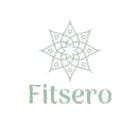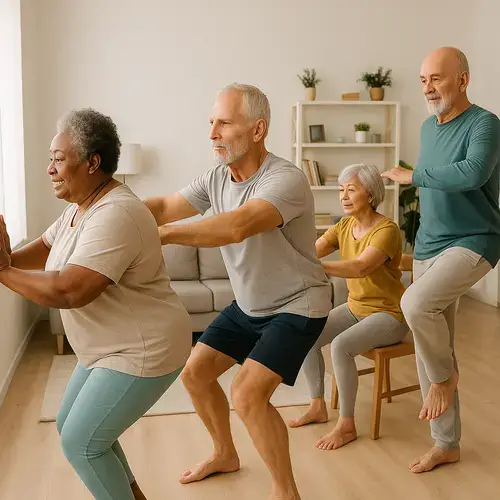Top Senior-Friendly Calisthenics: Exercises, Regressions, and Warm-Ups
Calisthenics for seniors offers a simple and effective way to stay strong, steady, and independent—without requiring long or complicated workouts. Good news: you can build real strength and balance with simple movements, right at home, in just minutes a day.

Disclosure: This article contains affiliate links. We may earn a commission at no extra cost to you.
Calisthenics gives seniors a practical, accessible way to build strength, balance, and mobility using just your own bodyweight. But here’s what really matters: starting with a proper warm-up. You’ll prepare your body, reduce injury risk, and honestly just feel better once you get moving.
Spend about five minutes on gentle, full-body movements to increase blood flow and loosen up your joints. Try two rounds of these:
- Marching in Place: Lift your knees to a comfortable height while swinging your arms—it loosens your shoulders and keeps your posture upright.
- Ankle Circles: Whether you’re seated or standing, rotate each ankle slowly, clockwise and then counterclockwise. This improves balance and foot mobility.
- Hip Hinges: Stand tall, then bend forward at the hips with your hands resting on your thighs. Keep your back flat to gently engage your lower back and hips.
- Shoulder Rolls: Roll your shoulders forward and backward a few times to release tension and improve overhead mobility.
Once you’re warmed up, do 8–10 reps of mini-squats—only as low as feels comfortable—and a few wall push-ups with a slow, controlled tempo. This primes your muscles and helps reduce fall risk before you tackle the main exercises.
Foundational Calisthenics Exercises and Progressions for Seniors
Let’s break down the core movements that’ll help you build strength safely and effectively.

- Wall or Incline Push-Ups
Purpose: Strengthen your chest, arms, and shoulders without stressing your wrists or lower back.
Regression: Start with push-ups against a wall—the closer you stand to the wall, the easier it is. As you get stronger, move to a countertop or lower surface.
Safety Tip: Keep your body in a straight line, don’t let your hips sag, and avoid flaring your elbows out too wide. - Chair Squats
Purpose: Build leg and hip strength while improving your balance and ability to stand up easily.
Regression: Use the armrests for support, or add cushions to decrease how far down you squat. Progress by briefly hovering just above the seat before standing back up.
Safety Tip: Make sure your knees stay aligned with your toes, and always use a sturdy chair without wheels. - Supported Rows or Resistance Band Pulls
Purpose: Activate your upper back and arms to improve posture and make lifting easier.
Regression: Anchor resistance bands higher to reduce how hard you have to pull. As you progress, use thicker bands or try bent-over rows with countertop support.
Safety Tip: Relax your shoulders and pull with your elbows, not your wrists. - Heel Raises
Purpose: Strengthen your calf muscles and improve balance.
Regression: Hold onto something sturdy when lifting both heels. Progress to one-leg raises or hold the top position longer.
Safety Tip: Stay upright and avoid rolling your ankles outward. - Glute Bridges
Purpose: Engage your glutes and lower back while taking pressure off your knees.
Regression: If getting down on the floor is tough, try seated hip presses by lifting your hips slightly off a sturdy chair.
Progression: Hold the bridge position longer or perform one-legged bridges.
Safety Tip: Don’t over-arch your back—squeeze your glutes at the top instead. - Bird Dog
Purpose: Enhance core stability and balance.
Regression: Lift just one limb at a time while keeping the others grounded.
Progression: Raise your opposite arm and leg at the same time, pausing briefly.
Safety Tip: Keep your hips level, and use padding under your hands and knees if needed.
You might also want to explore isometric holds—static exercises that build strength without movement. Wall sits, modified plank holds against a wall or countertop, and seated static presses are all excellent options for seniors. Build endurance gradually, prioritize form over duration, and don’t push yourself to hold positions too long too soon.
Here’s a general rule: move slowly and deliberately, maintain correct posture, and only progress when your basic movements feel stable and pain-free. If you’re new to exercise or returning after a break, it’s smart to check with your healthcare provider to make sure your routine suits your health status (Source: CDC).
Consistency with these exercises builds strength, confidence, and independence over time. If you’re looking for tailored, joint-friendly routines specifically designed for adults 40 and up, programs like the follow-along 7-minute routines for strength and mobility offer accessible sessions that require no equipment or gym visits.
Evidence, Risks, and Expert Guidance (Citations & Disclosures)
Calisthenics isn’t just popular—it’s backed by solid evidence. Studies show bodyweight exercises help older adults maintain muscle mass, bone density, balance, and functional independence. The American College of Sports Medicine endorses moves like chair squats, wall push-ups, and step-ups as effective ways to preserve physical function and reduce fall risk (Source: CDC).
A 2023 systematic review supports multimodal exercise interventions—including calisthenics and balance training—for lowering fall rates and enhancing daily living abilities in seniors (Source: British Journal of Sports Medicine).
That said, risks remain low for most active seniors. But if you’ve had recent fractures, severe osteoporosis, uncontrolled high blood pressure, cardiac conditions, or a history of serious falls, extra caution is necessary. Medical clearance and personalized assessments from licensed physical therapists are recommended in these cases (Source: NHS UK).
Experts emphasize the importance of tailored programs. Dr. Roger Fielding, PhD, at Tufts University, notes that when properly calibrated to your individual health and mobility, bodyweight resistance exercises are excellent for maintaining strength and balance. Dr. Dan Ritchie, PhD, advises prioritizing strength and functional movements over excessive cardio or restrictive diets to combat age-related muscle loss.
Our editorial content remains independent of commercial influences. Affiliate recommendations are clearly marked, and we always encourage you to critically evaluate products in consultation with your healthcare provider. For more beginner-friendly options and low-impact exercises, check out our guide to low-impact exercise for seniors.
Safe Volume, Intensity, Progression, and Programming for Older Adults
When you’re incorporating calisthenics into your routine, safety, manageable intensity, and gradual progression should be your top priorities. Health guidelines recommend 150 minutes weekly of moderate aerobic activity, plus muscle-strengthening exercises—like calisthenics—at least two non-consecutive days per week (Source: CDC).
Aim for a moderate effort level—you should be able to hold a conversation, but singing would be difficult. That corresponds to about a 5 or 6 on a 1–10 Rate of Perceived Exertion scale. Your movements should increase your heart rate and breathing without causing dizziness or strain.
Start with 1–2 sets of 8–15 reps per exercise, focusing on joint-friendly moves like chair squats or wall push-ups. Rest for 1–2 minutes between sets. Maintain strict form and never push through pain or discomfort. Warning signs like chest pain, unusual shortness of breath, or dizziness mean you need to stop immediately and get professional advice (Source: NHS UK).
Progress by increasing repetitions, sets, or slightly advancing exercise difficulty as you build comfort and strength. This might mean lowering the incline of your push-ups, sinking a little lower in your squats, or holding an isometric exercise a bit longer. Remember, quality matters more than quantity. Your primary goal is functional mobility and confidence, not just numbers.
To help you stay consistent, set aside regular time in your schedule for these exercises, and consider partnering with a friend, spouse, or workout group for added motivation and accountability. Even short, frequent sessions contribute meaningfully to your functional health. For more inspiration on consistency and building motivation, check out our advice on how to get more motivated for the gym or step-by-step how to get motivated to workout again.
If you’re looking for easy ways to stay moving every week, try mixing calisthenics with regular walks, easy stretching, or fun dance routines. Keeping workouts enjoyable boosts adherence and can help you overcome mental barriers on tired days. You’re building strength, not perfection—and that’s what matters most for long-term well-being.
Ready to follow an expert-designed routine that fits right into your day? Try these short calisthenics routines tailored for older adults to build strength and mobility at your pace.
Sources
Thank you for read my article for Calisthenics for Seniors

